AgentOps helps developers see inside their AI agents by logging every prompt, action, and cost. This review explains how it works, its features, setup, and why it’s becoming the go-to debugging tool for AI developers.
Stop Before You Buy: Read Our LiveAgent Review First!

LiveAgent, a comprehensive customer support software, offers a range of features including live chat, ticketing systems, and multi-channel communication capabilities, making it a popular choice for businesses seeking to streamline their customer service operations.
According to user reviews on G2, LiveAgent is praised for its ability to centralize customer inquiries from various channels and its efficient ticketing system, though some users note a learning curve in configuration.
LiveAgent Key Features
LiveAgent is a robust customer support platform designed to streamline communication across multiple channels. With its wide range of features, businesses can enhance efficiency, improve customer satisfaction, and manage workflows effectively.
1. Ticketing System
The ticketing system is central to LiveAgent’s functionality, ensuring all customer interactions are organized and tracked efficiently.
- Universal Inbox: Consolidates queries from email, live chat, social media, and contact forms into one inbox. Each ticket is assigned a unique reference number for tracking.
- Automated Distribution: Automatically assigns tickets to agents based on workload, topics, or departments. For example, sales-related queries go to the sales department, while product issues are routed to customer feedback teams.
- Hybrid Ticket Stream: Tracks customer interactions across multiple channels (email, social media, chat) within a single thread for seamless problem resolution.
2. Live Chat Features
LiveAgent offers advanced live chat functionalities to improve real-time communication with customers.
- Customizable Chat Buttons: Create unique chat buttons tailored to your website’s design. Options include corner buttons, bubble buttons, inline buttons, and custom HTML designs.
- Real-Time Typing View: Agents can see what customers are typing before they hit send, allowing faster responses and proactive service.
- Chat Embedded Tracking: Integrates with Google Analytics to track live chat events such as start/end chats and messages for detailed insights.
- Max Queue Length: Automatically hides the chat button when queues exceed predefined limits to prevent overwhelming agents.
- Internal Chat: Enables agents to communicate internally without leaving the dashboard. Includes file-sharing capabilities and clickable ticket links.
3. CRM Integration
LiveAgent’s built-in CRM allows agents to access customer data directly within the platform.
- Unified Customer View: View past tickets, purchases, and interactions while chatting with customers in real-time.
- Real-Time Updates: Agents can edit and update customer data during live chats or ticket handling.
4. Automation Tools
Automation features help streamline repetitive tasks and improve agent productivity.
- Canned Responses: Predefined replies for frequently asked questions that can be used across live chat, tickets, forums, Facebook Messenger posts, Viber messages, and more.
- Macros: Allows administrators to create templated responses for common inquiries or workflows.
- SLA Management: Ensures timely responses by setting service level agreements (SLAs) for tickets based on priority levels.
5. Multi-Channel Communication
LiveAgent supports communication across various platforms.
- Social Media Integration: Connects with Facebook, Twitter, Instagram, and other platforms to manage social media queries within the dashboard.
- Call Center Features: Includes automatic call distribution, attended transfers, callbacks, and personalized call handling using customer data.
- Email Management: Converts emails into tickets for streamlined tracking and resolution.
6. Reporting and Analytics
LiveAgent provides tools to monitor performance and optimize workflows.
- Dashboards: Offers detailed reports on ticket volume, agent performance, resolution times, and customer satisfaction metrics.
- Filters & Tags: Enables efficient searching of past tickets using tags or filters based on keywords or topics.
7. Self-Service Tools
Empower customers with self-service options to reduce direct support demands.
- Knowledge Base: Create FAQs, guides, and articles that customers can access independently through a dedicated portal.
- Customer Portal Customization: Add branding elements like logos and colors to align with company identity.
8. Advanced Features
LiveAgent includes several innovative features that enhance customer service experiences.
- Proactive Chat Invitations: Automatically invite website visitors to chat based on their browsing behavior or time spent on specific pages.
- Co-Browsing: Allows agents to join a customer’s browser session for guided navigation through the website.
- Current URL Tracking: Agents can see which pages visitors are browsing during live chats for context-aware support.
9. Third-Party Integrations
LiveAgent integrates with over 40 applications like MailChimp, Shopify, PipeDrive, Braintree, GoDaddy, Nicereply, and more.
- Perform actions directly within LiveAgent (e.g., adding deals in PipeDrive) without switching platforms.
- Save time by reducing clicks and logins through seamless integration workflows.
10. Branding & Customization
Businesses can personalize LiveAgent interfaces for better alignment with their brand identity.
- Customize chat windows with welcome messages or CSS styling options for a unique look.
- Add logos and custom color schemes to self-service portals.
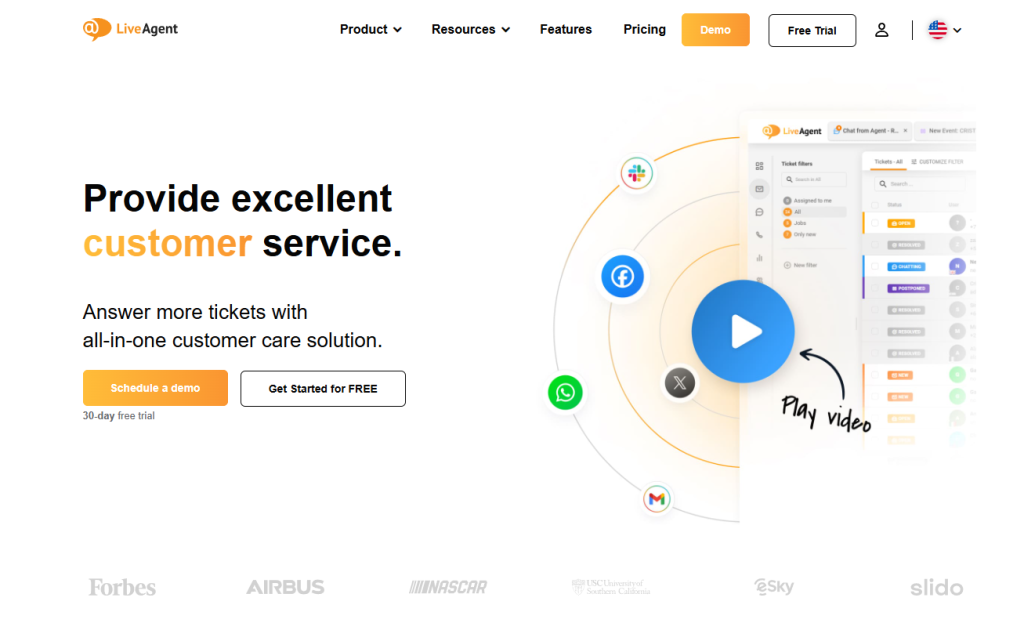
Referencing past interactions demonstrates that the company values the customer's history and understands their specific needs 5. This level of personalization can lead to stronger customer relationships and increased loyalty.
Strong problem-solving skills are critical for live agents. Effective problem-solvers combine critical thinking, creativity, and adaptability to address issues 6. They use a methodical approach, breaking large challenges into manageable steps and working both independently and collaboratively to find solutions.
Key steps in problem-solving include defining the issue, analyzing causes, brainstorming solutions, evaluating options, implementing a plan, and assessing results.
Maintaining professionalism and positivity throughout interactions is crucial, especially in challenging situations. A professional tone conveys credibility, respect, and clarity 3.
Agents should use courteous and respectful language, adapting their tone to the medium and audience while avoiding emotional or confrontational language 3. Even under pressure, staying calm and composed is essential 7. This approach helps de-escalate tense situations and ensures a positive customer experience.
By incorporating these key features, live agents can significantly improve their effectiveness, leading to higher customer satisfaction, stronger relationships, and ultimately, better business outcomes.
Evaluation Criteria
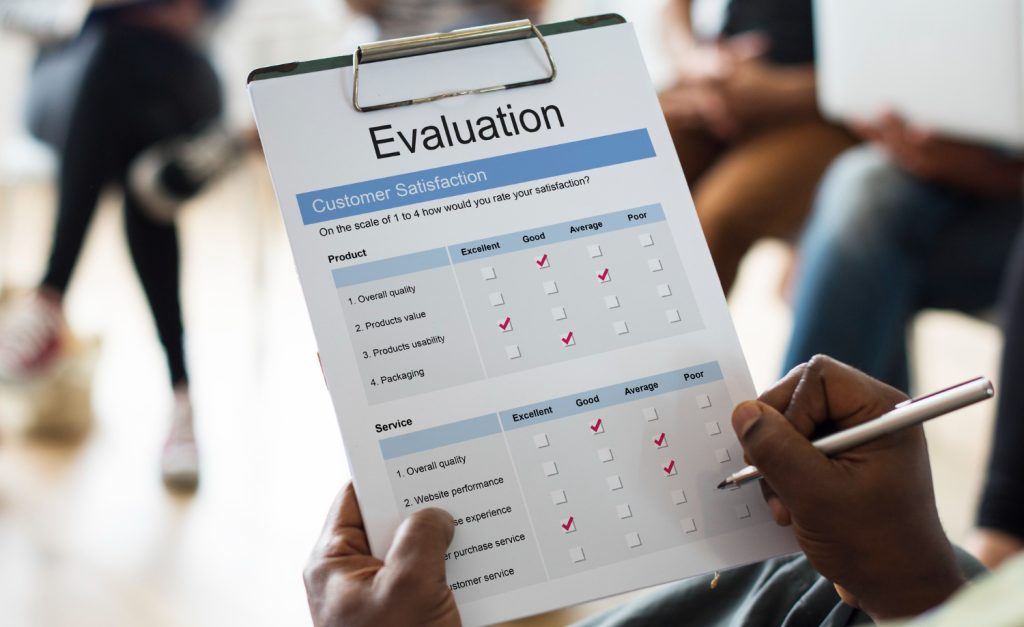
Evaluating live agent performance is crucial for maintaining high-quality customer service. Here are key criteria to consider:
Response Time: Quick responses are vital for customer satisfaction. The acceptable average wait time for a customer service agent to answer a call is about 30 seconds.
For digital channels, aim for first response times of 15 minutes for social media messages and 40 seconds for SMS. Average Speed of Answer (ASA) is a crucial metric, calculated as (Total wait time of all calls answered / total number of answered calls) 2. A lower ASA generally correlates with higher customer satisfaction.
Knowledgeability: Agents must possess comprehensive product knowledge to effectively address customer inquiries. This includes understanding features, benefits, pricing, target market, and competitive landscape 3. Product knowledge enables agents to provide accurate information, highlight benefits, and identify upsell opportunities. It's essential for building trust and credibility with customers 4.
Communication Skills: Effective communication involves using clear, simple language and avoiding jargon 5. Agents should adapt their tone to the situation - cheerful for positive interactions, helpful for neutral queries, and empathetic for complaints. Grammar, spelling, and the ability to simplify complex issues are crucial aspects of communication skills evaluation.
Empathy and Friendliness: Empathy involves understanding and sharing the customer's feelings, while compassion drives action to alleviate their concerns. Agents should demonstrate active listening, validate customer experiences, and show genuine willingness to help. This emotional connection fosters trust and loyalty.
Resolution Rate: First Contact Resolution (FCR) rate measures the percentage of customer issues resolved during the first interaction. It's calculated as (Number of issues resolved on first contact / Total number of customer support requests) x 100. A good FCR rate is generally considered to be around 70-75%. High FCR rates indicate efficient problem-solving and contribute to overall customer satisfaction.
Use of Tools: Effective agents skillfully utilize available tools without losing the human touch. This includes appropriate use of canned responses, templates, and AI assistance to enhance efficiency. However, it's crucial to maintain personalization and adapt responses to each unique situation. The goal is to leverage technology to improve service quality while preserving authentic human interaction.
By regularly evaluating these criteria, companies can identify areas for improvement, provide targeted training, and ultimately enhance their customer service quality.
Common Live Agent Scenarios
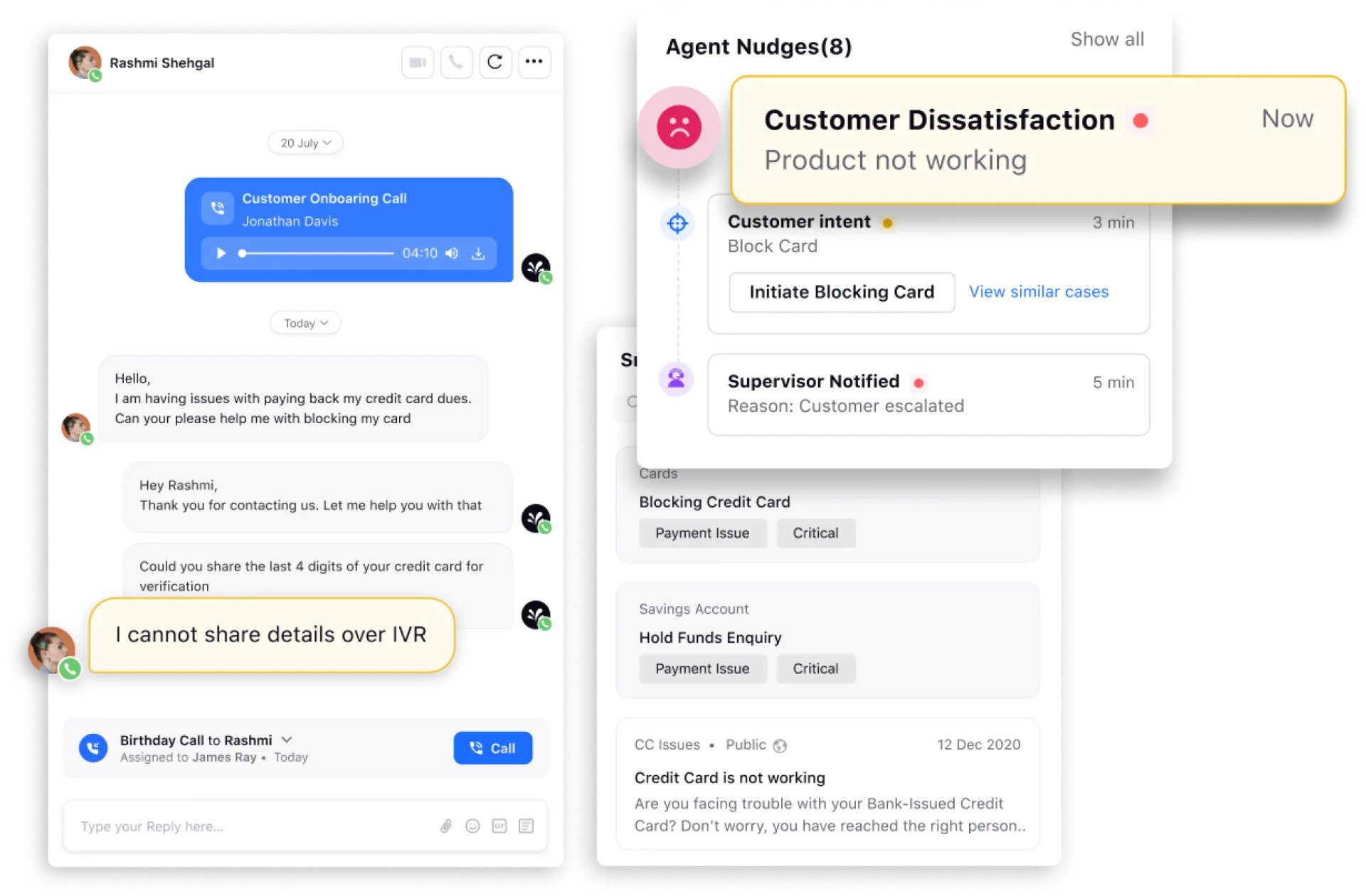
Live agents encounter various scenarios daily, each requiring specific skills and approaches. Here are some common situations and strategies for handling them effectively:
Handling billing inquiries:
Billing issues are among the most frequent customer service concerns. When addressing these, agents should:
- Verify the customer's identity and account details before discussing sensitive information.
- Clearly explain charges, fees, and payment terms.
- Offer multiple payment options and assist with setting up automatic payments if available.
- For complex issues, consider using visual engagement solutions to help customers understand their bills.
Technical support requires patience and clear communication. Agents should:
- Use a step-by-step troubleshooting approach, starting with basic solutions before moving to more complex ones.
- Employ screen sharing or video chat tools when possible to better understand and resolve the issue.
- Maintain a knowledge base of common problems and solutions for quick reference.
- Escalate to specialized technical teams when necessary, following a clear escalation matrix.
Effective product recommendations can enhance customer satisfaction and boost sales. Agents should:
- Ask probing questions to understand the customer's needs and preferences.
- Provide concise, relevant information about product features and benefits.
- Compare products objectively to help customers make informed decisions.
- Avoid pushy sales tactics and instead focus on finding the best solution for the customer.
Handling dissatisfied customers requires tact and empathy. Agents should:
- Acknowledge the customer's frustration and show genuine empathy.
- Listen actively to fully understand the issue before proposing solutions.
- Follow a defined escalation process when unable to resolve the issue personally.
- Offer concrete solutions or compensation when appropriate, based on company policies.
- Follow up with the customer after resolution to ensure satisfaction.
In all these scenarios, it's crucial for agents to maintain a professional and positive tone, even in challenging situations 6. Using pre-written scripts or templates can help ensure consistent, high-quality responses across various scenarios. However, agents should always personalize their communication to address each customer's unique situation effectively.
LiveAgent Chat Templates

Live chat templates are essential tools for customer support agents, providing pre-written responses for common queries and ensuring consistent, high-quality support. Here's a breakdown of best practices for live agents:
| Best Practice | Description |
|---|---|
| Use of pre-written templates | Employ standardized templates for greetings, inquiry gathering, and confirmations to maintain consistency and efficiency |
| Balancing automation with personalization | Combine AI-powered automation with personalized touches to create meaningful customer connections |
| Knowing when to escalate | Recognize complex issues that require specialized expertise and follow a clear escalation process |
| Ending conversations positively | Conclude chats with a positive tone, clear next steps, and an invitation for feedback |
Pre-written templates serve as a foundation for efficient communication, but personalization is key to creating authentic interactions. Agents should customize templates to match individual customer needs and the specific context of each conversation. This approach helps maintain a balance between efficiency and a human touch.
To effectively balance automation and personalization, consider implementing AI-powered tools that can adjust responses for appropriate tone and provide real-time assistance to agents. This technology can help optimize conversations while still allowing for human-centric interactions.
When faced with complex issues beyond their expertise, agents should know when and how to escalate. Establish a clear escalation matrix and train agents to recognize situations that require specialized support. This ensures that customers receive the most appropriate assistance for their needs.
Ending conversations on a positive note is crucial for customer satisfaction. Agents should summarize the interaction, confirm that all issues have been addressed, and provide clear next steps or follow-up information. Additionally, inviting customers to provide feedback can help improve service quality and demonstrate a commitment to customer satisfaction.
By implementing these best practices, live agents can deliver efficient, personalized, and effective customer support, ultimately enhancing the overall customer experience and fostering loyalty.
Best Practices for Live Agents

Live agents face several significant challenges in their day-to-day work, which can impact both their performance and well-being. Here's an overview of the key challenges:
| Challenge | Description |
|---|---|
| High volume of inquiries | Agents often experience work overload, managing multiple communication channels and resolving support tickets within strict time constraints |
| Dealing with difficult customers | Agents must handle angry, frustrated, or even abusive customers while maintaining professionalism and composure |
| Balancing speed and quality | Agents need to provide quick responses while ensuring thorough and accurate solutions to customer issues |
The high volume of inquiries can lead to burnout, with 77% of agents reporting increased and more complex workloads compared to the previous year 5. This constant pressure can result in emotional exhaustion and decreased job satisfaction. To address this, companies should consider implementing automated customer service options to offload some of the agents' work and improve workflows.
Dealing with difficult customers is a significant stressor for agents. They must remain calm and professional while absorbing customers' frustrations 3. Training in de-escalation techniques and empowering agents to set clear, respectful boundaries can help manage these challenging interactions 6.
Balancing speed with thoroughness is crucial, as customers expect immediate responses but also comprehensive solutions. Agents must navigate this delicate balance to maintain high customer satisfaction levels while meeting efficiency targets 4. Implementing knowledge management systems and providing ongoing training can help agents deliver quick yet thorough responses.
Challenges Faced by Live Agents

Live agent performance can be significantly enhanced through the use of specialized tools designed to streamline communication and improve efficiency. Zendesk offers AI-powered live chat software that enables personalized conversations at scale, with features like automated translation and intelligent ticket routing 1.
LiveAgent provides a customizable chat widget, canned responses, and real-time typing view to preview customer messages. TextExpander allows teams to share text snippets across devices and platforms, saving time on common responses while maintaining a personal touch.
Key features that boost agent productivity include:
- Canned responses: Pre-written replies to common queries, saving keystrokes and ensuring consistency.
- AI-powered suggestions: Tools like Zendesk AI can automatically suggest relevant responses and flag topics where new canned responses could be created.
- Analytics and performance tracking: Real-time monitoring and performance analysis help identify areas for improvement and provide targeted coaching.
- Omnichannel support: Integration of multiple communication channels into a unified workspace for seamless customer interactions.
- Knowledge bases: Centralized repositories of information that agents can quickly access to resolve customer issues efficiently.
These tools not only improve response times and consistency but also allow agents to focus on more complex issues, ultimately enhancing the overall customer experience.
Tools that Enhance Live Agent Performance
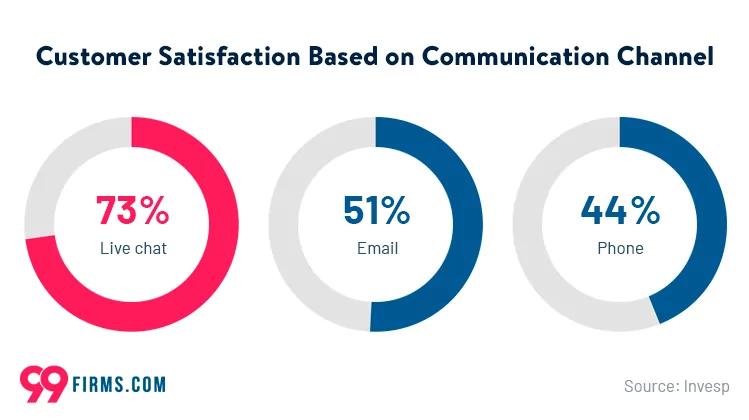
Skilled live agents play a crucial role in enhancing customer satisfaction and loyalty by providing personalized, empathetic support that builds trust and fosters long-term relationships. Studies show that 83% of customers prefer human interaction for resolving issues, highlighting the irreplaceable value of live agents in customer service 1.
To improve live chat experiences, businesses should focus on comprehensive agent training, emphasizing the HEARD technique (Hear, Empathize, Apologize, Resolve, and Diagnose) to ensure customers feel valued and understood 2.
Implementing advanced tools like AI-powered suggestions and analytics can significantly enhance agent performance and efficiency 4. However, it's essential to strike a balance between automation and personalization to maintain the human touch that customers appreciate.
By continuously analyzing chat performance data, setting clear KPIs, and providing ongoing training, companies can create a customer-centric live chat experience that not only resolves issues promptly but also builds lasting customer relationships, ultimately driving business growth and success.
Real world Case Studies From LiveAgent Users

In an era where customer expectations are constantly evolving and instant gratification is the norm, businesses must adapt their service strategies to stay ahead. LiveAgent has emerged as a pivotal solution, offering a robust platform that integrates cutting-edge technology with human-centric support.
GEODIS: Global Logistics Optimization
As a €15.07B logistics conglomerate operating across 67 countries, GEODIS implemented LiveAgent to unify 50,000 employees’ customer interactions across email, social media, and 12 regional call centers. Post-implementation metrics showed:
- 40% reduction in cross-departmental ticket transfers
- 28-second average response time for urgent shipment inquiries
- 91% resolution rate for customs documentation issues
A senior GEODIS executive noted: “LiveAgent’s SLA automation ensures compliance with EU freight regulations—we auto-tag high-priority pharmaceutical shipments for <2-minute responses”.
SATUR Travel Agency: Multilingual Support Breakthrough
Slovakia’s largest travel provider (90,000+ clients annually) credits LiveAgent with:
- 60% faster response times across 8 languages
- 325% increase in paid customer conversions
- 44% reduction in peak-season escalations
Key implementation features included AI-powered language detection routing inquiries to native-speaking agents and integrated visa document verification workflows.
FrëschKëscht: From Classroom to Commercial Kitchen
This Luxembourg-based meal kit startup (originally a school project) scaled operations 15X using LiveAgent’s:
- Chat-to-order conversion templates: Prefilled cart links reduced checkout time by 73%
- Recipe troubleshooting KB: 85% self-service resolution for cooking queries
- SMS payment reminders: Cut failed deliveries by 62%
CEO Marc Schmit stated: “LiveAgent became our virtual sous-chef—handling 90% of customer dialogues while we focused on sourcing” 2.
Lampdirect.nl: Lighting Up E-Commerce Efficiency
The Netherlands’ premier lighting retailer (€50M-100M revenue) achieved:
- 22% chat engagement boost via floating neon chat widgets
- 31% cart recovery rate through abandoned cart sequences
- 4.7/5 CSAT via post-chat surveys
Their LiveAgent configuration includes AR product demos for bulb compatibility checks and automated warranty registration during chats 3.
Post Affiliate Pro: Scaling Partner Support
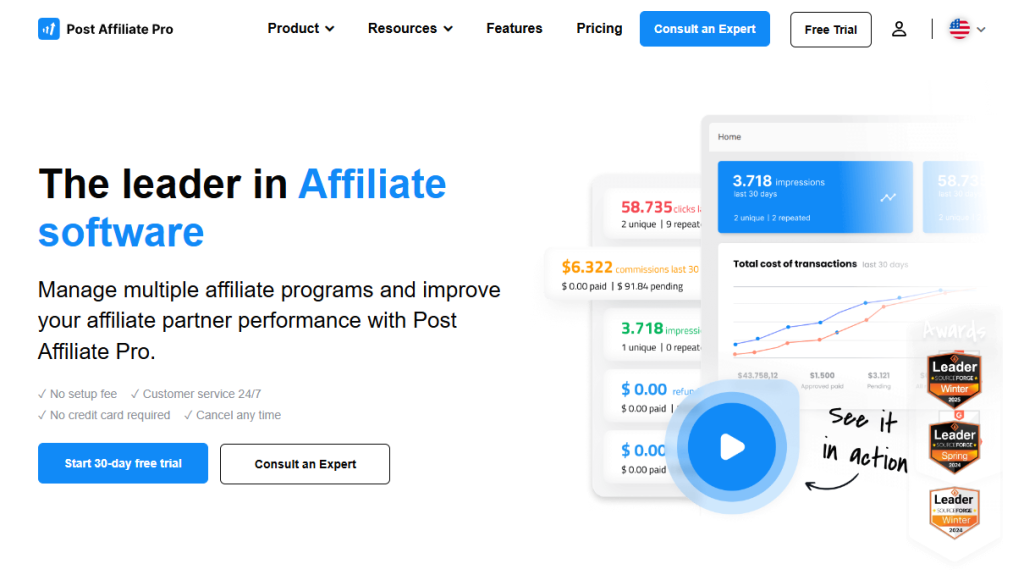
Used by 30K+ businesses for affiliate tracking, this platform integrated LiveAgent to:
- Automate 78% of tier-1 inquiries via chatbot/KB combos
- Reduce chargeback disputes 55% with screen-recording evidence capture
- Achieve 98% SLA compliance through priority tagging for premium clients
CTO Ján Vítko highlighted: “Agents now resolve 325% more tickets monthly without quality loss—a game-changer for SaaS support”.
Websupport: Hosting Heroes
Central Europe’s leading web host (1M+ domains) leverages LiveAgent for:
- SSH diagnostic integration: 41% faster server issue resolution
- Domain expiry cascades: Auto-sent 30/15/1-day renewal reminders
- DDoS attack protocols: Instant routing to security specialists
This reduced support tickets by 27% despite 19% YoY customer growth.
Forest Holidays: Booking Experience Transformation
UK’s premium cabin retreat operator reported:
- 89% satisfaction during 3X volume surges via LiveAgent’s auto-surge staffing
- 22% upsell success using chat-based activity recommendations
- AR cabin tours: 44% fewer pre-arrival queries
Operations Director Emily Hart noted: “Guests book add-ons like firewood bundles mid-chat after visualizing cabin layouts”.
Team Lyders (Taco Bell Franchise): Fast-Food Tech
This $1.8B revenue franchise deployed LiveAgent to:
- Predict order intent via typing speed analysis (83% accuracy)
- Integrate POS systems for real-time coupon validation
- Auto-translate drive-thru chats for 18 language groups
Resulting in 31% higher app-order completion rates and 19% labor cost savings.
Capterra Verified Reviews (4.7/5 Avg 1679 Reviews):
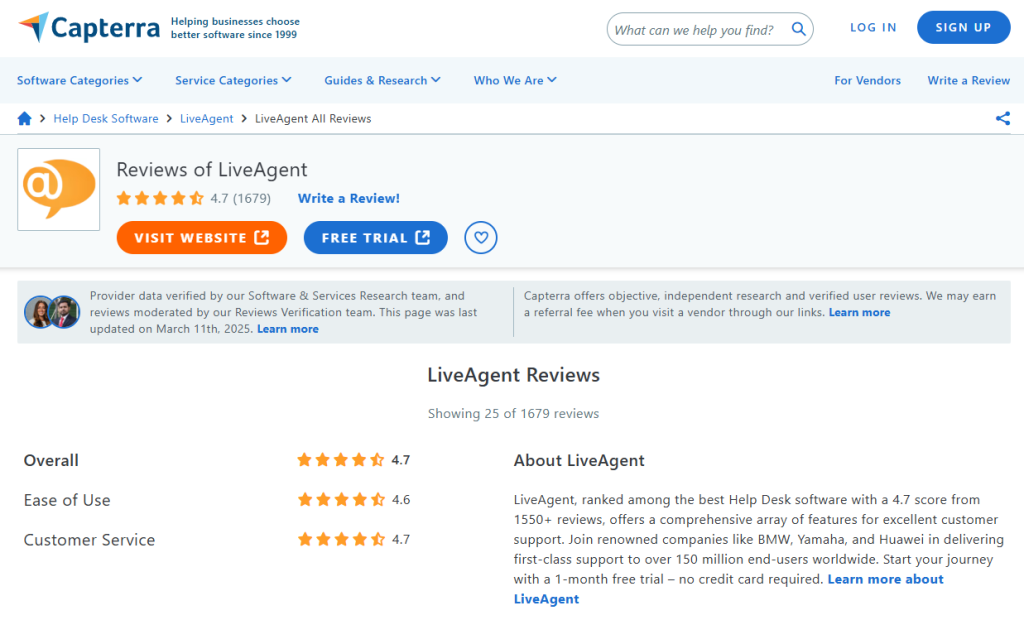
- MaxMilhas (Brazilian Travel Tech): “Google Maps API integration lets us visualize customer locations during flight rebooking chats”
- BCS Technology (Australian IT Services): “Team transfer notes prevent repetition—saves 6.5 minutes per complex ticket”
- Trendimi (Irish Fashion Platform): “Geo-targeted chat availability increased European conversions 22%”
Areas for Improvement:
- Spam Filter Tuning: Multiple retailers noted recurring spam from same addresses despite markups
- Reporting Customization: Some users desire deeper cohort analysis beyond standard dashboards
- Billing Flexibility: A real estate firm requested annual payment options vs monthly
Pros and Cons of LiveAgent
Pros
- Easy Setup and Implementation
- Comprehensive Features
- Offers a robust set of features including live chat, ticketing system, social media integration, and a knowledge base.
- Includes advanced features like real-time typing preview, customizable chat buttons, and proactive chat invitations.
- Multi-Channel Support
- Supports multiple communication channels such as email, social media, and live chat, allowing for a unified customer service experience.
- Automatically converts social media posts and emails into tickets for streamlined management.
- Customization and Scalability
- Highly customizable to fit business needs, with options to brand and personalize the interface.
- Scalable for businesses of all sizes, from small startups to large enterprises.
- Customer Support
- Offers exceptional customer support with a multilingual interface, making it suitable for global businesses.
- Provides comprehensive reporting and analytics to evaluate support team performance.
- Cost-Effective
- Offers a free plan and competitive pricing for paid plans, making it a cost-effective option for emerging businesses.
Cons
- Mobile App Limitations
- The mobile app's interface could be improved for better usability.
- Limited Integrations
- Some users feel that LiveAgent could support more integrations with business systems to enhance its effectiveness.
Pricing Plans for LiveAgent

LiveAgent offers a range of pricing plans designed to cater to different business needs, from small startups to large enterprises. Each plan includes a variety of features that can be tailored to suit specific customer service requirements.
1. Free Plan
- Cost: Free
- Features:
- Live Chat: One live chat button, basic chat functionality.
- Ticketing System: 7-day ticket history.
- Multi-Channel Support: Limited to email.
- Knowledge Base: Not included.
- Additional Features: Basic reporting, limited customization options.
- Ideal For: Small businesses or solo entrepreneurs testing the waters with customer service software.
2. Small Plan
- Cost: $15 per agent/month (billed annually)
- Features:
- Live Chat: Unlimited live chat buttons, customizable chat windows.
- Ticketing System: Unlimited ticket history.
- Multi-Channel Support: Includes email, but limited social media integration.
- Knowledge Base: Basic knowledge base creation tools.
- Additional Features: API integrations, basic reporting tools, canned messages.
- Ideal For: Small businesses with a dedicated customer support team looking for basic features.
3. Medium Plan
- Cost: $29 per agent/month (billed annually)
- Features:
- Live Chat: Proactive chat invitations, real-time visitor monitoring.
- Ticketing System: Includes all features from the Small Plan.
- Multi-Channel Support: Enhanced social media integrations (e.g., Facebook, Twitter).
- Knowledge Base: Advanced knowledge base creation tools.
- Additional Features: Time tracking, SLA management, advanced reporting.
- Ideal For: Growing businesses that need more advanced customer service tools, including proactive engagement and deeper analytics.
4. Large Plan
- Cost: $49 per agent/month (billed annually)
- Features:
- Live Chat: All features from the Medium Plan, plus advanced chat customization.
- Ticketing System: Includes all features from previous plans.
- Multi-Channel Support: Comprehensive integration with call center functionality (IVR, video calls).
- Knowledge Base: Advanced knowledge base with feedback options.
- Additional Features: Call center features like IVR, video calls, and call routing, advanced reporting and analytics.
- Ideal For: Large enterprises requiring robust customer service solutions with advanced call center capabilities.
5. Enterprise Plan
- Cost: Custom pricing for large-scale businesses.
- Features: Tailored solutions including all features from the Large Plan, plus:
- Dedicated support and onboarding.
- Custom integrations and development.
- Advanced security options.
- Ideal For: Large corporations or organizations with unique customer service needs that require personalized solutions.
Discounts and Promotions
- Annual Billing Discount: LiveAgent offers a discount for annual payments compared to monthly billing.
- Free Trial: A 14-day free trial is available for all plans, allowing businesses to test features before committing.
Overall, LiveAgent's pricing structure is designed to be flexible and scalable, accommodating businesses as they grow and expand their customer service operations.
Conclusion
Skilled live agents are crucial in enhancing customer satisfaction and loyalty, with 90% of customers considering live chat helpful and 63% more likely to return to a website where they received assistance from a live chat agent 1.
By employing active listening techniques and providing personalized support, agents ensure customers feel understood and valued, directly impacting overall satisfaction and fostering stronger relationships.
To improve live chat experiences, businesses should focus on comprehensive agent training, implement AI-powered tools for efficiency, and adhere to best practices such as prompt responses and clear communication. Utilizing features like canned responses and AI-assisted suggestions can help balance speed with personalization 4.
Regular evaluation of agent performance using criteria like response time, knowledgeability, and resolution rate is essential for maintaining high-quality customer service 5. By continuously refining their live chat strategy, companies can create exceptional customer experiences that drive loyalty and business growth.

